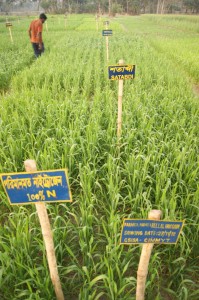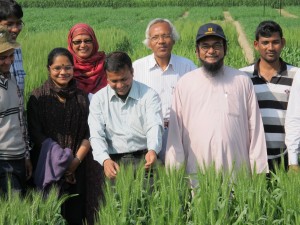Objectives
CSISA is composed of six objectives:
 Objective 1: Through its innovation hubs, CSISA aims to catalyze the widespread dissemination of production and post-harvest technologies to increase cereal productivity, resource use efficiency, and income. Anticipated outputs of Objective 1 include participatory testing and technology refinement for sustainable intensification; translating research into actionable products and insights; mobilizing partnerships for catalyzing impact at scale; and strategic capacity development to support key agents of change.
Objective 1: Through its innovation hubs, CSISA aims to catalyze the widespread dissemination of production and post-harvest technologies to increase cereal productivity, resource use efficiency, and income. Anticipated outputs of Objective 1 include participatory testing and technology refinement for sustainable intensification; translating research into actionable products and insights; mobilizing partnerships for catalyzing impact at scale; and strategic capacity development to support key agents of change.
Objective 2: Through its research platforms, CSISA aims to conduct process-based research into crop and resource management practices for future cereal-based systems. Research platform activities are conducted in order to (i) assess medium-term performance and sustainability of current and proposed new systems and (ii) continue with dynamic optimization of the proposed new management systems. Four cropping systems scenario treatments have been implemented at all four of the CSISA research platforms: Scenario 1: business as usual—conventional farmers’ practices; Scenario 2: known best management practices (integrated crop and resource management); Scenario 3: labor-, energy-, and water-saving drivers of change (conservation agriculture based); and Scenario 4: futuristic, intensified and/or diversified systems (conservation agriculture based).
Objective 3: Through plant breeding, CSISA aims to develop high-yielding, heat- and water-stress-tolerant rice varieties for current and future cereal and mixed crop-livestock systems. Objective 3 develops a new generation of rice varieties and hybrid parental lines for the target regions of South Asia. The target trait specifications used in the variety development pipelines emphasize higher yield potential, adaptation to dry direct seeding and water stresses (partial/non-flooded irrigation), heat tolerance, grain quality, and straw fodder value. Objective 3 provides products for Objectives 1 and 2, including new lines that will be well adapted to conservation agriculture practices.
 Objective 4: Through plant breeding, CSISA aims to develop high-yielding, heat- and water-stress-tolerant, and disease-resistant wheat varieties for current and future cereal and mixed crop-livestock systems. Objective 4 strives to develop bread wheat varieties that improve on those currently available, have higher yields, are well buffered against the vagaries of climate change, and have end-use quality. Objective 4 aims to develop input-responsive varieties that also have greater resistance to biotic stresses such as leaf, yellow, and stem rusts, and spot blotch/leaf blight; as well as better nutritional and end-use quality, and adaptability to conservation agriculture practices.
Objective 4: Through plant breeding, CSISA aims to develop high-yielding, heat- and water-stress-tolerant, and disease-resistant wheat varieties for current and future cereal and mixed crop-livestock systems. Objective 4 strives to develop bread wheat varieties that improve on those currently available, have higher yields, are well buffered against the vagaries of climate change, and have end-use quality. Objective 4 aims to develop input-responsive varieties that also have greater resistance to biotic stresses such as leaf, yellow, and stem rusts, and spot blotch/leaf blight; as well as better nutritional and end-use quality, and adaptability to conservation agriculture practices.
Objective 5: Through policy research, CSISA aims to contribute to the development of improved policies and institutions for inclusive agricultural growth. CSISA Objective 5 continues to address the policy environment needed to remove constraints to the adoption of new technologies and enhance the benefits of improved agricultural growth. Objective 5 specifically explores strategies to catalyze durable change at scale through improvements in technology development and delivery, private investment in inputs and services, and public-private partnerships. The main research areas under Objective 5 are improved policies and incentives that encourage private investment and public–private partnerships in pro-poor technology development and delivery, and improved policies and incentives that address changing labor, gender, assets, and migration dynamics related to pro-poor technology development and delivery.
Objective 6: CSISA is committed to high-quality project management, data management, monitoring and evaluation, and communications. CSISA’s governance and project management mechanisms are designed to (i) enable better linkages with national and regional stakeholders, (ii) simplify reporting and ensure clear lines of accountability, (iii) enable better teamwork and synergy across Objectives and CG partners, and (iv) build a more inclusive model for outreach and research that leverages the strengths and addresses the needs of key partners.
